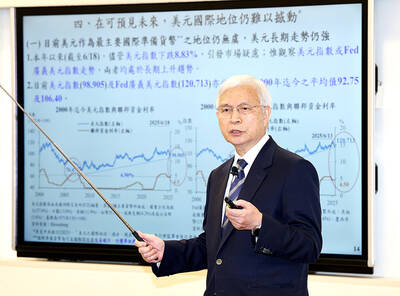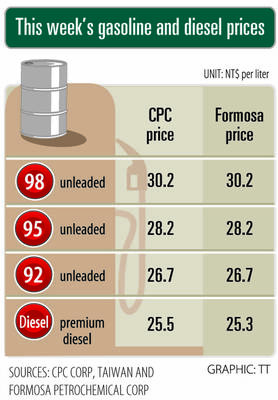The HSBC manufacturing purchasing managers’ index (PMI) for Taiwan rose above the neutral mark for the first time in nine months to 52.7 last month, thanks to stabilizing demand and restocking activity, a report by the banking group showed yesterday.
All but one sub-indices moved out of contraction last month, suggesting industrial production should hold up for another month, although concerns remain over international uncertainties, the monthly report said.
“Taiwan is fending off the impact of faltering European demand better than expected,” HSBC economist Donna Kwok (郭浩庄) said in the report.
With a still fragile recovery in the US and China, risks to growth remain tilted to the downside, she added.
A PMI value above 50 indicates expansion, while a lower reading suggests contraction.
Incoming new business flows swung the indices to expansion for the first time since May last year, with the sub-index on new orders rising from 47.4 in January to 54.2 last month, while the sub-index on new export orders bounced back from 46.9 to 53.8, the report said.
The report also showed a significant pickup in the output sub--index, which rose from 46.1 in January to 53.8 last month, suggesting production activity is likely to remain steady next month and beyond.
After seven consecutive months of destocking, manufacturers started to step up -purchasing and increase their inventories of finished goods last month, pushing the sub-index on stocks of finished goods from 48.1 to 52 and the sub-index on stocks of purchases from 48.2 to 51.8, the report said.
Employment conditions also improved, as the sub-index inched higher from 50.2 in January to 51.3 last month, it said.
While the output price -reading moved above the 50 level for the first time in eight months last month, tough competition helped keep inflation at historically low levels, Kwok said.
In all, “the latest PMI reading provides an encouraging outlook for Taiwanese manufacturers, but the results should be taken with a pinch of salt because the US and China are just not out of the woods yet,” she said.

NOT JUSTIFIED: The bank’s governor said there would only be a rate cut if inflation falls below 1.5% and economic conditions deteriorate, which have not been detected The central bank yesterday kept its key interest rates unchanged for a fifth consecutive quarter, aligning with market expectations, while slightly lowering its inflation outlook amid signs of cooling price pressures. The move came after the US Federal Reserve held rates steady overnight, despite pressure from US President Donald Trump to cut borrowing costs. Central bank board members unanimously voted to maintain the discount rate at 2 percent, the secured loan rate at 2.375 percent and the overnight lending rate at 4.25 percent. “We consider the policy decision appropriate, although it suggests tightening leaning after factoring in slackening inflation and stable GDP growth,”

DIVIDED VIEWS: Although the Fed agreed on holding rates steady, some officials see no rate cuts for this year, while 10 policymakers foresee two or more cuts There are a lot of unknowns about the outlook for the economy and interest rates, but US Federal Reserve Chair Jerome Powell signaled at least one thing seems certain: Higher prices are coming. Fed policymakers voted unanimously to hold interest rates steady at a range of 4.25 percent to 4.50 percent for a fourth straight meeting on Wednesday, as they await clarity on whether tariffs would leave a one-time or more lasting mark on inflation. Powell said it is still unclear how much of the bill would fall on the shoulders of consumers, but he expects to learn more about tariffs

Greek tourism student Katerina quit within a month of starting work at a five-star hotel in Halkidiki, one of the country’s top destinations, because she said conditions were so dire. Beyond the bad pay, the 22-year-old said that her working and living conditions were “miserable and unacceptable.” Millions holiday in Greece every year, but its vital tourism industry is finding it harder and harder to recruit Greeks to look after them. “I was asked to work in any department of the hotel where there was a need, from service to cleaning,” said Katerina, a tourism and marketing student, who would

i Gasoline and diesel prices at fuel stations are this week to rise NT$0.1 per liter, as tensions in the Middle East pushed crude oil prices higher last week, CPC Corp, Taiwan (台灣中油) and Formosa Petrochemical Corp (台塑石化) said yesterday. International crude oil prices last week rose for the third consecutive week due to an escalating conflict between Israel and Iran, as the market is concerned that the situation in the Middle East might affect crude oil supply, CPC and Formosa said in separate statements. Front-month Brent crude oil futures — the international oil benchmark — rose 3.75 percent to settle at US$77.01